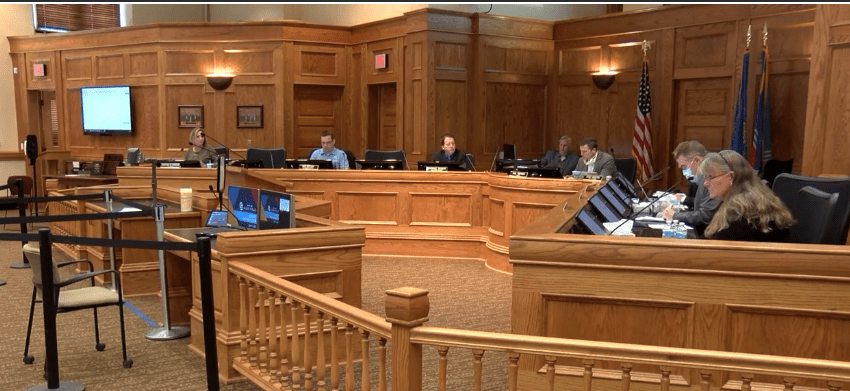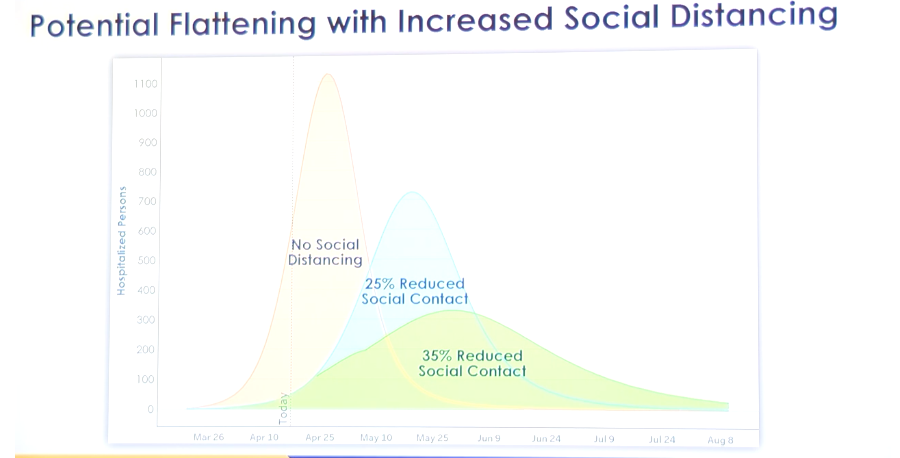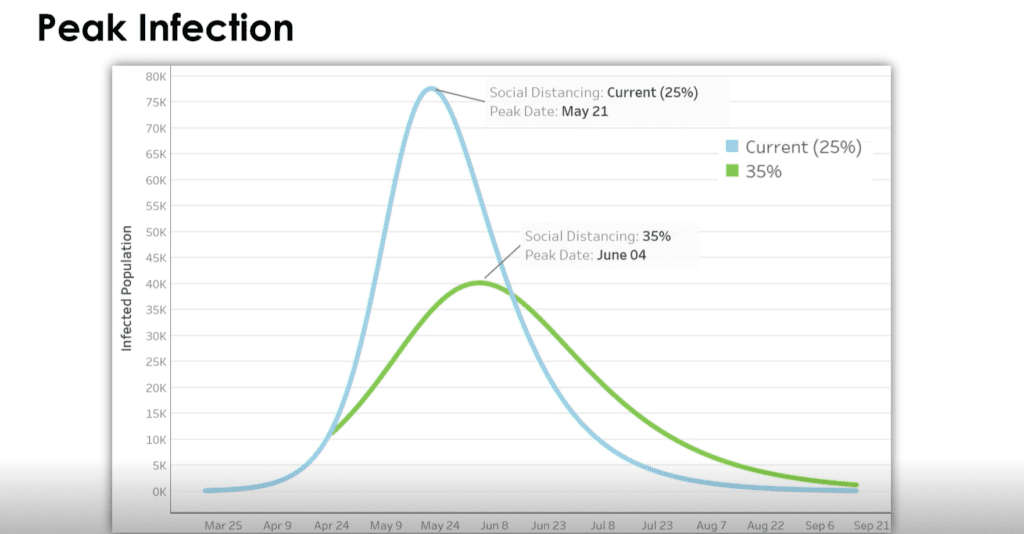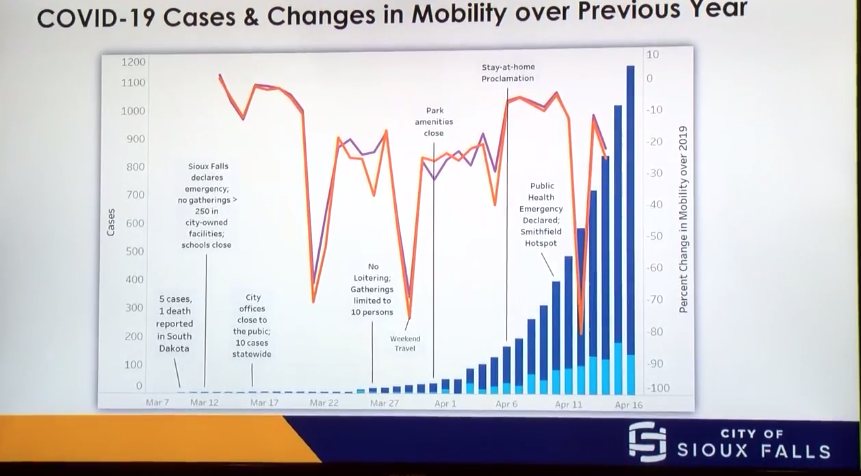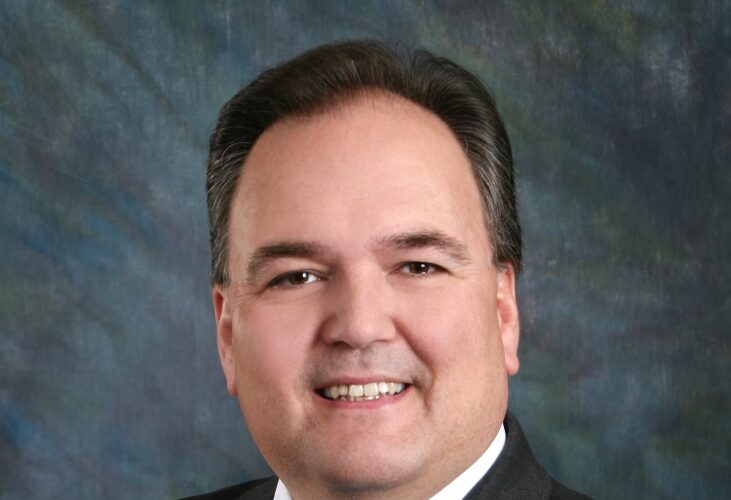City: Stay-at-home order needs to ‘pivot’ to more regulation around no lingering
April 17, 2020
New data shows the city of Sioux Falls could slow the spread of COVID-19 with tighter regulations but could stop short of a stay-at-home order, Mayor Paul TenHaken told the City Council on Friday.
“Our current stay-at-home order needs to pivot based on today’s data,” he said. “I feel that the measures we still have to take in our city to further flatten our curve can be enhanced through enhanced regulations in our no-lingering ordinance and not in a stay-at-home order.”
The council was scheduled to vote on the ordinance next week, and it would have gone into effect April 24.
The goal now is to “target where population density is highest,” he said. “Mandatory mask wearing, mandatory temperature checks for large employers or large companies or other potential measures.”
The data is a compilation of information and assumptions from the state, Avera and Sanford specifically for Minnehaha and Lincoln counties.
The peak of COVID-19 hospitalizations in the Sioux Falls area will have the health care systems operating at maximum capacity, but they “feel they can meet the current COVID demand,” TenHaken said. “It creates an opportunity for us to determine what measures we can deploy to further flatten the curve and provide our health care partners more of a capacity buffer while also providing the needed support to the businesses and employees of our community.”
City GIS specialist Aileen Profir shared what would happen to the city’s curve of cases with varying degrees of social distancing. The city currently estimates it is at 25 percent social distancing. A stay-at-home order could increase it to 35 percent, the city estimated.
This is an estimate of projected infection rates, which includes people who will have mild symptoms and likely won’t be tested.
The city also showed how volumes of people moving around town have changed in recent weeks.
Using a 25 percent social distancing approach, the city is “knocking on the ceiling” of hospital capacity at peak, TenHaken said.
Representatives of both health systems said it is difficult, but doable.
“We can make that work with our existing business of strokes, heart attacks, those types of things,” said Dr. Jeremy Cauwels at Sanford Health.
The hospitals will take any help they can get in controlling the volume, said Dr. David Basil of Avera Health.
The projected numbers are “well, well, well beyond any number of ICU patients we’ve cared for in this city before,” he said.
“Do we have a plan? Yes. Is it well beyond anything we’ve done before? Yes.”
TenHaken encouraged the City Council to review the data with an open mind.
“Public health and protecting lives has been and will continue to be my No. 1 priority in this response,” he said.
“There is no greater duty for an elected official than to protect the lives of the constituents he or she is serving. That is what drives me right now. that is what keeps me up at night.”
The mayor and city attorney have not had a chance to connect on whether the proposed stay-at-home ordinance should be voted down or withdrawn but will make a determination by early next week. The goal is to determine what more the city can do to protect the capacity of the health system without enacting a stay-at-home ordnance.
“It’s very challenging for me to say that we should do less right now,” TenHaken said. “What I would like us to consider as a council on this ordinance … is have you as a council potentially look at bringing any amendments you would feel comfortable to our existing no-lingering ordinance.”
Anything the city can do to help with mitigation will give the hospitals desired breathing room, TenHaken said.
“The issues are where people gather en masse. What do we have to do? Do we need temperature checks that are required at large businesses? Do we need to have people wearing masks in Hy-Vees, Lowe’s, Home Depot? Have that be in ordinance? We’re not telling a business you can’t operate your manufactuirng facility. But it’s in ordinance you need to check temperatures and anyone above this needs to be turned away.” “
Some of those measures would help in not taking the full stay-at-home ordinance, he added.
“Because I think it’s pretty much decided we’re either voting that down or we’re pulling it. I don’t have all the answers. Those are a couple we’ve talked about to ensure business compliance. I’ve had conference calls with the CEOs of probably the 50 biggest employers of this city and have begged, pleaded, done anything I can to get them to comply.”
He’s still getting emails from whistle-blowers at employers, he said.
“I don’t know what else I can do. And some whistle-blowers are at some pretty substantial companies that should know better. I’d love to figure that out with the council between now and Tuesday if there’s something we can agree on that would help us move the needle.”

